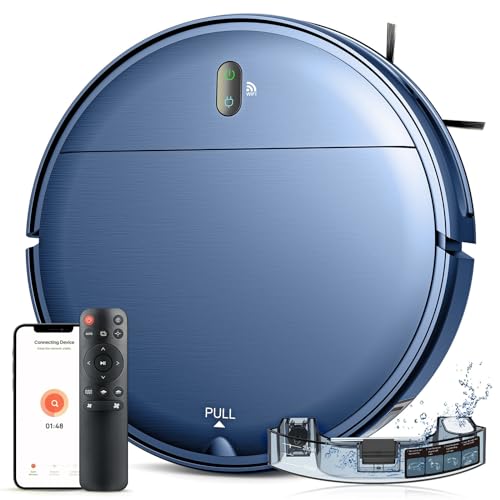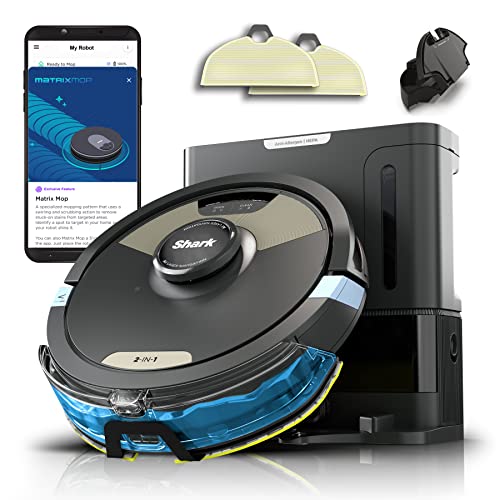10 Things You Learned In Kindergarden That Will Help You With Robot Va…
페이지 정보
작성자 Milagros 댓글 0건 조회 43회 작성일 24-03-02 22:12본문
 Robot Vacuum and Mop - Hands-Free Cleaning Made Easy
Robot Vacuum and Mop - Hands-Free Cleaning Made EasyThink about this two-in-one cleaner if you're looking for an appliance that can do all. It can mop hard floors and vacuums low- and medium-pile carpet. its app lets you design areas that are not mopped and alter cleaning schedules and modes.
Look for models with sensors that can recognize the type of floor they're on as well as empty dirt and water from their tanks, and avoid obstacles such as phone chargers, pet hair, and socks. Also, learn how easy it is to install.
Self-Emptying
People are always looking for robot vacuum and mop ways of lessening their workloads as the world gets more frantic and hectic. Robot vacuums and mop are among the top tools available to help with that. These machines can vacuum pet hair, dirt and crumbs, while simultaneously cleaning floors. You can even use a smartphone or a voice assistant to control them using pre-programmed schedules and specific room designations.
One of the biggest time-savers for both the users and machines is self-emptying models that don't need you to empty out the trash bin after each cleaning cycle. This saves you a lot of effort and ensures your robot can clean your entire house more often, without having to worry about running out of space in the bin before it's time for a refill.
If you're thinking of a model that self-empties make sure you check the size of the dustbin because it could quickly fill up if it is frequently used. You should also ensure that the system does not overfill, causing an obstruction that stops the robot from being able to empty it fully.
The self-emptying feature works by taking the dust bin inside the machine and placing it in a larger storage container -- think of it as the bag that comes with a traditional vacuum cleaner -and then emptying it every two or three times. The robots are worth the extra cost because they feature this top feature.
Some models wash and dry dirty pads automatically after each use. Some models have a dock that takes care of the entire job and you only need to empty it twice or once a year.
Check out this Roborock robotic that is highly rated for its ability to complete both tasks. The RockDock-S7 MaxV Ultra can both mop and vacuum, thanks to a an exclusive dock that handles all the maintenance for you. You can schedule the unit to start by using voice assistants like Alexa or Google Assistant. You do not need to empty the tanks manually. It even has boundaries to keep it out of certain zones if you don't want it roaming around your entire home.
Object Avoidance
The best robot vacuums feature object avoidance, which aids the machine move through furniture legs and toys for children. This feature is essential for families with pets and children, as the robot could jam or break in the event of hitting them.
The technology is typically built around a single sensor, or a pair of sensors located close to the bumpers of the vacuum cleaner that absorb shock. Once these sensors detect an obstacle the robot will then turn and reorient itself until it finds an easy path. Certain models utilize lidar technology that uses lasers to determine the distance between the robots and other objects. This enables it to create an image of its surroundings in real time and move more efficiently through your home.
Other robovacs that don't use lidar technology are designed to make use of binocular or monocular vision to recognize obstacles using cameras. These systems are most effective in bright light however they don't perform as well in low-light conditions or with objects that are the same color as the environment. For instance, a robot with monocular vision might have trouble recognizing cables or shoes.
Some robot vacuums are more advanced than others, and they can accomplish more than just avoiding obstacles. This is why they are also called smart vacuums. They can build a virtual map of your home's layout and allow you to direct them to specific areas or rooms using the application. They'll even remember where they've cleaned before which will reduce the time spent cleaning and ensure that your home is spotless.
The most advanced robotic vacuums and mops can switch between different floor types. Some robot vacuums and mops will automatically recognize the flooring type in a certain room and adjust suction and the brush functions to match. Some even allow switching from hard flooring to carpet without affecting suction power.
Whatever the flooring, all smart vacuums and mops must be equipped with some sort of obstacle avoidance. These devices prevent the vacuums from getting tangled in a web or wires that can cause them to lose their suction. Some models are equipped with a list of objects they are aware to look for, including shoes, socks and pet waste. The most effective models can recognize these objects and calculate their size, distance and even avoid them without running into it.
Floor Mapping
The majority of robot vacuums have sensors that aid in detecting objects. If an object, like furniture legs or a toy thrown in a random way or gets in the the vacuum cleaner's path, sensors will inform it to steer away and to a cleaner area of the floor. These sensors are not foolproof. The Roomba 900 Series, for instance, was able avoid our shoeslaces and headphones but it did end up sucking into a cable. We recommend moving objects away from the robot's path before letting it move through your home.
A lot of the vacuums and mopping robots that we have tested in The Spruce include an app. It can be used to save maps, make schedules, select cleaning options and track your robot's performance. The top apps provide features that make your ion robot vacuum more efficient. They are easy to use and simple to use.
App integration can also help you keep the track of the robot's water tank as well as dirty pads. You should look for models that let you determine the level of the water tank as well as the amount of wetness on the pad and when the pad needs to be changed. You can also program a schedule to automatically changes the pad when it's wet to keep mildewy smells out of growing on the old one.
The mapping feature is important for robot vacuums which work across multiple floors. It allows the robot to create an imaginary map of your house that it can use to navigate between rooms and clean the different areas more thoroughly. Some robots combine sensors and artificial intelligence to create maps. For instance, iRobot's Vacuuming Mapping feature uses multiple sensors to scan a room, including corners and walls, to determine how far it can travel before bumping into obstacles or hitting furniture.
Other robots, including the Ecovacs Deebot X1 OMNI and the Roborock S7 MaxV Ultra, use optical sensors to determine where walls are. They can then follow the edges of furniture or use a mapping algorithm to design the best route for each room.
Mopping Sets
Robot vacuums work automatically, with you doing nothing more than hitting a button on a remote or an app to have them clean a room. You can also make use of voice commands to set schedules which is a useful feature for busy families that would like their robot to complete its tasks at the same time every day.
Many robot mops come with microfibre pads that are soaked by water tanks that are located at the bottom. They are able to be used multiple times before they have to be replaced or washed. Models that allow for adjustment of water flow to suit different floors are ideal. You should also take into consideration the size of your tank, the ability to switch between wet mopping and dry mopping, and the amount of time a robotic mop will last on one charge.
The best robot mops will quickly and efficiently clean hard floors, getting under tables and around obstacles that you'd have difficulty doing manually. They're not perfect, though they're not perfect, and may struggle to get up and down stairs or over ledges that separate rooms. They can leave streaks on tiles or timber particularly in the sun.
A high-quality robot vacuum and mop ought to also come with a sensor that can detect and avoid carpet. This is a vital feature if you have mixed floor types in your home, since it means that the cleaner won't be sucked up by or be dragged across the rug. It should also be able to detect other objects that could interfere with the cleaning process, such as cords or tassels, and permit you to create no-go zones that prevent the robot from entering those areas.
The majority of the robots we test in our CHOICE lab come with a smart app integration that lets you save your home's map as well as set cleaning schedules and select cleaning options. You can also set up virtual barriers to keep your robot from certain areas and receive (sometimes humorous) error alerts when the device is having issues. Certain apps are simpler to use than others, whereas others provide live webcams to monitor your robot.

댓글목록
등록된 댓글이 없습니다.

